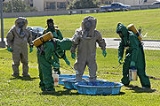
Dangerous goods
Overview
Solid
Solid is one of the three classical states of matter . It is characterized by structural rigidity and resistance to changes of shape or volume. Unlike a liquid, a solid object does not flow to take on the shape of its container, nor does it expand to fill the entire volume available to it like a...
s, liquid
Liquid
Liquid is one of the three classical states of matter . Like a gas, a liquid is able to flow and take the shape of a container. Some liquids resist compression, while others can be compressed. Unlike a gas, a liquid does not disperse to fill every space of a container, and maintains a fairly...
s, or gas
Gas
Gas is one of the three classical states of matter . Near absolute zero, a substance exists as a solid. As heat is added to this substance it melts into a liquid at its melting point , boils into a gas at its boiling point, and if heated high enough would enter a plasma state in which the electrons...
es that can harm people, other living organism
Organism
In biology, an organism is any contiguous living system . In at least some form, all organisms are capable of response to stimuli, reproduction, growth and development, and maintenance of homoeostasis as a stable whole.An organism may either be unicellular or, as in the case of humans, comprise...
s, property, or the environment. They are often subject to chemical regulations
Regulation of chemicals
The regulation of chemicals is the legislative intent of a variety of national laws or international initiatives such as agreements, strategies or conventions. These international initiatives define the policy of further regulations to be implemented locally as well as exposure or emission limits...
. "HazMat teams" are personnel specially trained to handle dangerous goods. Dangerous goods include materials that are radioactive, flammable, explosive, corrosive
Corrosive
A corrosive substance is one that will destroy or irreversibly damage another surface or substance with which it comes into contact. The main hazards to people include damage to the eyes, the skin, and the tissue under the skin; inhalation or ingestion of a corrosive substance can damage the...
, oxidizing, asphyxiating
Asphyxiant gas
An asphyxiant gas is a non-toxic or minimally toxic gas which reduces or diplaces the normal oxygen concentration in breathing air. Prolonged breathing of oxygen depleted air can lead to death by asphyxiation...
, biohazard
Biohazard
Biohazard may refer to:* Biological hazard* Biohazard , a book by Ken Alibek* Biohazard , a New York hardcore punk band** Biohazard , a self-titled album from Biohazard...
ous, toxic, pathogen
Pathogen
A pathogen gignomai "I give birth to") or infectious agent — colloquially, a germ — is a microbe or microorganism such as a virus, bacterium, prion, or fungus that causes disease in its animal or plant host...
ic, or allergen
Allergen
An allergen is any substance that can cause an allergy. In technical terms, an allergen is a non-parasitic antigen capable of stimulating a type-I hypersensitivity reaction in atopic individuals....
ic. Also included are physical conditions such as compressed gases and liquids or hot materials, including all goods containing such materials or chemicals, or may have other characteristics that render them hazardous in specific circumstances.
Dangerous goods are often indicated by diamond-shaped signage.
Unanswered Questions

